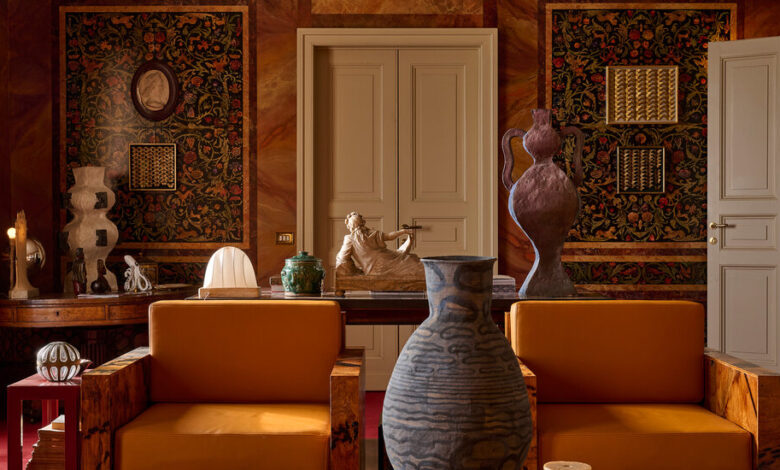The 12 Best Things We Saw at Salone Del Mobile

This year’s Salone del Mobile furniture fair, which took place this week in Milan, fell much earlier in April than usual. But that didn’t spare visitors from the sneezing fits the city’s springtime pollen shed can bring — or from the long lines and late nights that are now part of the event, which in recent years has become even bigger than the city’s fashion week. There was plenty of chatter about how shifting tariffs might affect the industry but, in all other ways, the fair was business as usual, with big design brands launching new projects and fashion houses getting in on the action with homewares collections or — in some cases this year — surprising, experimental collaborations. Below, a dozen projects that stood out.
Loewe’s Ode to the Teapot
Group design exhibitions that feature a single type of object — for example, mugs or stools — have become a mainstay over the past few years. For its latest design-world homage to craftsmanship, the Spanish fashion house Loewe, which presented an array of lamps at last year’s fair, commissioned 25 artists and designers from around the world to produce their take on a teapot. The resulting pieces resemble miniature sculptures, and among the highlights were the American artist Dan McCarthy’s lumpy ceramic vessels adorned with his signature childlike faces; a purple airbrushed version by the Spanish architect and designer Patricia Urquiola; and a frosting-like swirl of white clay by the Japanese ceramist Takayuki Sakiyama.
An Artistic Take on Headboards
The family-run Italian brand Bolzan has been manufacturing high-end beds since the early 1990s, but this year it hired the Treviso-based design duo Zanellato/Bortotto to curate a collection of headboards as expressive as they are functional. The pair invited four designers to contribute works that included floating blue fabric draped across a hidden wood frame, conceived by Julie Richoz, and a piece by India Mahdavi featuring a customizable bar of large, colorful ceramic beads.
Textiles That Channel Midcentury Designs
Each edition of the fair brings fresh reissues of archival furnishings by major designers from past decades. Two of the most exciting releases this year were textile based: The Milanese rug producer Amini paid homage to the graphic and product designer Bruno Munari by transforming t six designs adapted from his Flights of Fancy and Useless Machines series into carpets. And the Milanese luxury fabric house Dedar partnered with the Josef & Anni Albers Foundation to bring back five of Anni’s designs from the 1930s to the 1970s. It’s the first time Albers’s textile designs have been faithfully produced as stand-alone upholstery fabrics.
A New Twist on Metal Furniture
Chrome and steel have become ubiquitous in the design world lately, but a collaboration between the young Parisian interiors firm Studio Haddou Dufourcq and the 145-year-old French metalworking house (and, more recently, furniture brand) Pouenat explored the lesser-sung appeal of aluminum. Kim Haddou and Florent Dufourcq — whose burgeoning portfolio includes a hotel in Hyères and an Hermès store in Saint-Tropez — designed a collection of satin-and-nickel-plated aluminum chairs, mirrors, shelves and lamps that read like a contemporary reinterpretation of classical decorative elements, including Louis XIII twisted-wood frames and Josef Hoffmann-esque ball accents.
Dimorestudio’s 1970s Villa and Furry Chairs
Dimorestudio, the Milanese design firm known for channeling Old World Italian glamour, presented no less than five major exhibitions during Salone. The trademark immersive scenography of the company’s founders, Britt Moran and Emiliano Salci, was on full display at a much-talked-about imaginary 1970s-80s house the pair conjured to showcase new furniture created for Loro Piana Interiors. But across town, they dispensed with the theatrics to put the spotlight on limited-edition seating made in collaboration with the French outerwear brand Yves Salomon: five metal-and-fur chairs and benches designed in response to the founder’s personal collection of fanciful Art Nouveau wood furniture by Carlo Bugatti.
An Extra-Fuzzy Take on Shag Rugs
Best known for his bright, blurry-edged watercolors of animals, the Amsterdam-based illustrator and graphic designer Rop van Mierlo brought his colorfully hazy aesthetic to a collection of five shag rugs for the Italian brand CC-Tapis. Presented alongside new offerings from big names like Bethan Laura Wood, India Mahdavi, Patricia Urquiola and Cristina Celestino, van Mierlo’s rugs are based on loose, gridlike patterns he created using his signature wet-on-wet painting technique and bring to mind the vibrant Scandinavian high-pile rya rugs of the 1970s.
Experimental Glass in a Maze of Showers
A show by the Milan-based 6:AM Glassworks got fairgoers talking, in large part because of its fascinating venue: a maze of public showers, abandoned since the 1970s and situated beneath a still-functioning public pool designed in the 1930s by the Italian architect Luigi Lorenzo Secchi. Beyond an opulent waiting room adorned with an aquatic-themed mosaic, the raw concrete shower stalls each held a different glass lamp, vase or sculpture — many of them wonky prototypes or wild experiments. With wonder at every turn, it felt like a welcome break from the more commercial side of the Milan fair.
Casa Cabana’s Craft Show
Martina Mondadori, the founder of Cabana magazine, invited fairgoers into Casa Cabana — the publication’s special-events space located in her childhood home, with circa 1978 maximalist interiors by the Italian designer Renzo Mongiardino — for an exhibition curated by the writer (and former T editor in chief) Deborah Needleman. The show highlighted six makers approaching traditional crafts with fresh techniques and included furniture made by New York’s Green River Project in collaboration with the fashion designer Emily Adams Bode Aujla. Constructed from plywood, the pieces underwent an intense staining and weathering process to give them the appearance of more luxurious burl wood — an illusion that brought to mind the visual trickery that Mongiardino incorporated into the space with, for example, glass panels around a fireplace painted to look like marble.
A Multitude of Michael Anastassiades Lights
The Cypriot-born, London-based lighting designer Michael Anastassiades presented his latest works in the stately headquarters of the Jacqueline Vodoz and Bruno Danese Foundation, which houses both the archives of the Italian design brand Danese, which they co-founded, and their personal collection of art and objects. Visitors were greeted with a display of small 1950s fabric sculptures by the frequent Danese collaborator Bruno Munari that were echoed in the triangular paper panels of Anastassiades’s new collection of pendant lamps, Cygnet. Meanwhile, at the Salone del Mobile fairgrounds across town, the Italian brand Flos launched a line of Anastassiades-designed pendants composed of linear glass modules that can be strung together to form long, vertical ropes of light.
A Sculptor and Designer’s Legacy Revived
The London design gallery Béton Brut started in 2013 as a purveyor of rare vintage furniture and, in 2022, expanded into commissioning contemporary work. Now the gallery is representing its first artist’s estate, that of the Treviso-based sculptor and furniture maker Salvino Marsura, who worked primarily in iron and steel in a style often referred to as organic Brutalism. In Milan, they exhibited his pieces, all from the 1960s and ’70s, in two separate shows: three large-scale sculptures were placed in the garden at the upstart design fair Alcova’s Villa Borsani location, while several smaller works were shown alongside new fabric lights and steel frame sofas by the Milan- and London-based furniture and interiors duo Tutto Bene at their studio near Parco Sempione.
A Celebration of Polish Design
The Polish Vogue publisher Katarzyna Jordan’s new Visteria Foundation, which promotes the work of Polish designers and artists, debuted its first exhibition, entitled “Romantic Brutalism,” at the offices of Studio Penta, a textiles agency. Curated by Federica Sala, the show included pieces by 24 designers installed in a 10-room space that had been outfitted with painterly wallpaper and colorful carpeting by the Warsaw interiors firm Paradowski Studio. The designs on view included sculptural metal benches and vessels by the up-and-comer Jan Ankiersztajn and lighting by Dérive Studio made from sustainable 3-D-printed shades suspended from delicate stainless-steel scaffolds.
Jil Sander’s Colorful Thonet Chairs
For her first-ever foray into furniture, the fashion designer Jil Sander collaborated with the German brand Thonet on a subtle reinvention of two Bauhaus design classics: the Hungarian-born Modernist furniture designer Marcel Breuer’s classic S 64 chair from 1929-30 — the instantly recognizable cantilevered seat with a tubular steel frame — and matching B 97 side table from 1933. Sander offered two collections, one with more neutral finishes like white oak and a warm nickel, and one that introduces bolder colors like burgundy and green, along with high-gloss lacquer.




